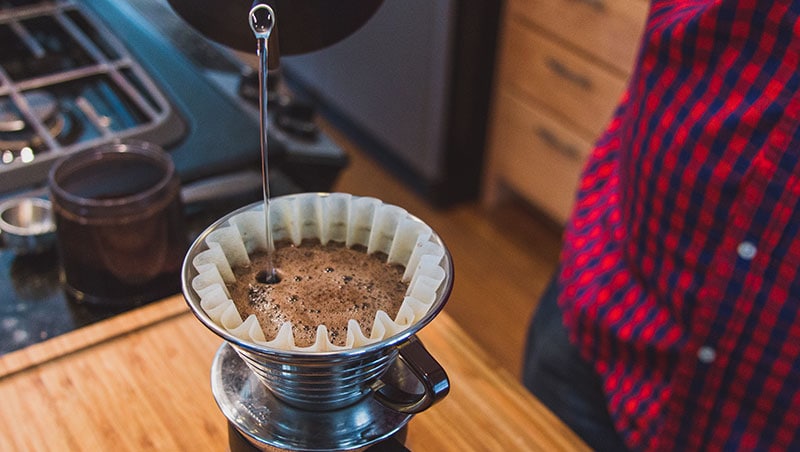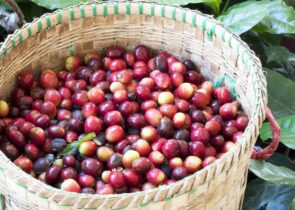
If you want to brew a cup of coffee at home that tastes as flavorful and robust as the cup you get at your local coffee shop, you’re in luck. A quick and easy process called blooming your coffee can help turn your favorite fresh grounds into the rich brew you’re looking for. Best of all, it’s easy!
While there are some variations depending on your brewing method, blooming coffee is the process of adding a small amount of hot water to your fresh coffee grounds, then waiting a short time before adding the rest of the water for brewing.
Fine-tune your understanding of this process and you’ll be well on your way to making your best-tasting cup of java yet.
Let’s learn how to bloom coffee…
What Is Coffee Bloom and Why Does it Happen?
Whether you’re a casual coffee drinker or an aficionado, you’ll benefit from understanding this simple piece of coffee science.
Coffee bloom is simply the fast release of gas that occurs when hot water comes in contact with the coffee grounds. It’s a quick chemical reaction, but it has a huge impact on flavor.
When coffee beans are roasted, carbon dioxide and other gases form inside the bean. The beans immediately begin to slowly discharge these gases in a process known as “degassing.” The degassing process is slow, though, so beans that were roasted less than about two weeks ago will still contain some carbon dioxide.
As soon as the beans are ground, the gases begin to escape much more quickly. When hot water touches the ground coffee, they immediately begin to purge themselves of the carbon dioxide and other volatile compounds. This creates the bloom effect.
How Does Coffee Bloom Impact Flavor?
The carbon dioxide that bubbles up during coffee bloom can negatively impact the flavor of your coffee for two reasons.
First, carbon dioxide has a sour taste, and if you proceed with brewing your java while the CO2 is still degassing, some of that sour flavor will make its way into your beverage.
CO2 degassing has another effect, too. To make the most delicious and flavorful cup of coffee, the hot water needs to extract flavor from the ground coffee beans.
The carbon dioxide being expelled prevents the water from getting into the beans to extract the compounds that give flavor to the coffee. Think of it as a “traffic jam”- the water can’t get in while the carbon dioxide is trying to get out.
Blooming coffee allows the carbon dioxide and other gases to get out of the way, giving the brew water the best possible access to the coffee grounds.
This is done by adding a small amount of hot water to the grounds, then waiting a short period for the coffee to degas before adding the rest of the water.
When the water can make optimal contact with the grounds, you’ll notice a difference in the flavor profile. Sugars take more time to be dissolved by water than acids, so when the water has plenty of time to interact with the grounds, the coffee will taste sweeter and more robust. Under-extracted coffee tends to be more acidic and has a sour taste.
How To Bloom
Coffee bloom is often associated with the pour-over method, but it’s beneficial for all brewing methods.
The basic process for coffee blooming is the same no matter how you brew your coffee- add a small amount of hot water to the grounds and wait a minute or so.
However, the exact process varies depending on the type of coffee maker you use,
Pour Overs
Pour very hot water on the coffee in a circular motion beginning from the outside and then working your way into the middle.
Only use a little water. You want the coffee to become soaked but not drip through the filter.
You’ll see the grounds swell up, and bubbles will form on top. Allow it to set for about one minute before you make your cup of coffee.
French Presses
For French Press owners, slowly pour a small amount of hot water over coarsely ground coffee.
Let the bloom stand for about 20 seconds, then stir it with your spoon to be sure all the grinds come in contact with the water.
After that, you can continue with your normal brewing routine.
Automatic Drip Coffee Makers
Place your filter in your coffee maker’s filter basket and add your ground coffee to it.
Add just enough water over the top of the grounds to soak the coffee but not enough that it will drip through the filter.
Allow it to set for about 90 seconds and then begin your normal brewing cycle on your drip coffee maker.
Espresso
When using a manual espresso machine, blooming your coffee is called pre-infusion.
To pre-infuse, lift the lever only part way so that water flows freely onto the puck. You don’t want to engage the pump yet.
After around 2-10 seconds, lift the lever all the way to engage the pump.
Cold Brew
Yes, even your cold brew coffee can benefit from blooming! The hot bloom/cold brew method will give the best results for degassing.
Add your coarsely ground coffee to the container you usually use to make your cold brew.
Pour a small amount of hot water over the grounds and let them bubble and degas for around 30-45 seconds. Then proceed with your usual cold brew process, using cold water.
Fresh Roasted Versus Ground Coffee
Volatile compounds within the roasted coffee bean bring flavor to the brewed coffee. When the CO2 escapes from the coffee bean, it takes those flavor compounds with it.
While the normal loss of carbon dioxide and other gases begins as soon as the roasting process is complete, coffee roasted within the last couple of weeks will still contain some of these gases. For the best flavor, opt for the most freshly roasted beans you can get.
When coffee is ground, the gases can escape much more easily. This is why most serious coffee drinkers always grind their coffee just before they use it.
One of the best ways to make sure you’ve always got fresh-roasted coffee on hand is getting it delivered monthly via a coffee subscription.
Other Variables That Affect Bloom
Many variables affect the bloom. The following factors impact the rate at which the gas is lost in the beans after they have been roasted, which will then affect how much bloom you see.
Temperature
The hotter the area in which the beans are stored the faster the gas will escape from the beans.
Ideally, try to store the beans in a cooler environment away from anything that generates heat such as the lighting in your kitchen or on your stove.
Humidity
Gas will escape more quickly from the beans in a drier area. Of course, high humidity levels will encourage mold and other fungi to grow.
Ideally, you want to find the perfect balance in your humidity levels to protect the gas and shield your beans from mold.
Roast Level
The type of roast will have a large influence on the bloom. Darker Italian roasts, for example, undergo much less degassing compared to other types of roasts.
Bean Origin
The origin of the coffee bean can also impact the bloom as some coffees are known to undergo more degassing than others.
Bean Hardness
The harder the bean, the more difficult it is for the carbon dioxide to make its way through the bean and escape.
FAQs
How Much Water Do You Use to Bloom Coffee?
A rule of thumb is to use about 2 grams of water for each gram of coffee.
If you don’t like pulling out a scale in the morning, aim to add just enough water to wet the grounds, but not so much that it drips through the filter (if you’re using one).
Can You Over Bloom Coffee?
We can’t find any evidence that blooming coffee for a longer period of time will impact the flavor. However, keep in mind that blooming your coffee turbo-charges the degassing process, and flavor compounds escape along with the CO2.
Brew your coffee soon after blooming it, typically after around a minute, for the best results.
Why Is My Coffee Not Blooming?
The main reason you might not see your coffee blooming is that your beans were stale, roasted more than about two weeks ago, or were not freshly ground.
In some cases, dark roasts won’t produce as much bloom as lighter roasts.
Should I Bloom Using Hot or Cold Water?
You should bloom using hot water. The hot water speeds the release of carbon dioxide from your coffee grounds, leaving them ready to make a more tasty cup of coffee.
How Long Should I Bloom My Coffee?
Let your coffee bloom for 30 seconds to a minute, or until you see the bubbling subside.
The notable exception is espresso, which should only be pre-infused for around 2-10 seconds.
What Does Coffee Bloom Look Like?
When your coffee is blooming, you’ll see the grounds rise and swell. Small bubbles will form on top of the grounds.
Does Blooming Coffee Matter?
Allowing your coffee to bloom, or de-gas, before continuing the brewing process definitely has an impact on flavor extraction.
With freshly roasted and recently ground beans, giving the coffee time to bloom will always allow the flavor of the coffee to be richer and more developed. It also eliminates the sour taste that the escaping CO2 would otherwise leave behind.
With that being said, many home coffee drinkers may be used to the sour and acidic taste of under-extracted coffee and may prefer this taste.
Additionally, coffee that is older or has been pre-ground will have largely degassed already. In these cases, the coffee won’t bloom much, if at all, anyway, so blooming the coffee won’t matter.
The Final Case for Blooming Your Coffee
True coffee aficionados go to great lengths to create the perfect cup, from using the best and freshest beans to carefully measuring their brew times.
The science is clear that allowing your coffee to bloom will make way for the best flavor extraction, so why not try it?
With less than a minute of your time and a few grams of water, you could make your most satisfying brew yet!
Happy Caffeinating!









